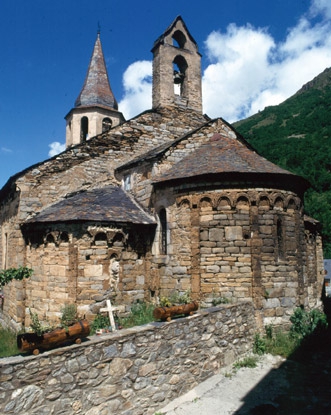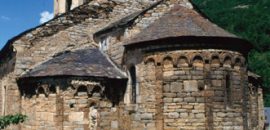Type:Church
Century: XII, XVI,XVIII
Architectural Style: Romanesque-Gothic-Renaissance
Village: Unha
Municipality: Naut Aran
Santa Eulària de Unha is a church of Romanesque origin, faithful to the architectural configuration of the period, with its basilical three-nave ground plan, the central one with semicircular vault and the side naves with quarter sphere; to the East, three apses decorated in the Lombardy style; finally a belfry was added in the NW angle in the 18th Century.
To begin with, the church of Unha is the only church in the Aran Valley which conserves its Romanesque wall paintings, located in the semi-sphere of the central apse. These paintings have fragments of what the figure of the Pantocrator would have been (the face is conserved) located in the mandorla and surrounded by the Tetramorph.
The presence of wall paintings does not finish here; paintings from the 16th Century were recently discovered and restored, sequentially depicting the biblical episodes of Jesus praying in the Garden of Gethsemane, Judas’ kiss, the scourging, Pontius Pilate washing his hands, the road to Calvary, the Crucifixion and the Final Judgement with Christ Glorified.
The Romanesque legacy of the church of Santa Eulària can also be appreciated through the presence of its baptismal fonts. Of the two it conserves, one is a plunging-type baptismal font, and might have been a reused sarcophagus. The other baptismal font, with basin and support leg, reproduces the same archaism and decoration motifs.










